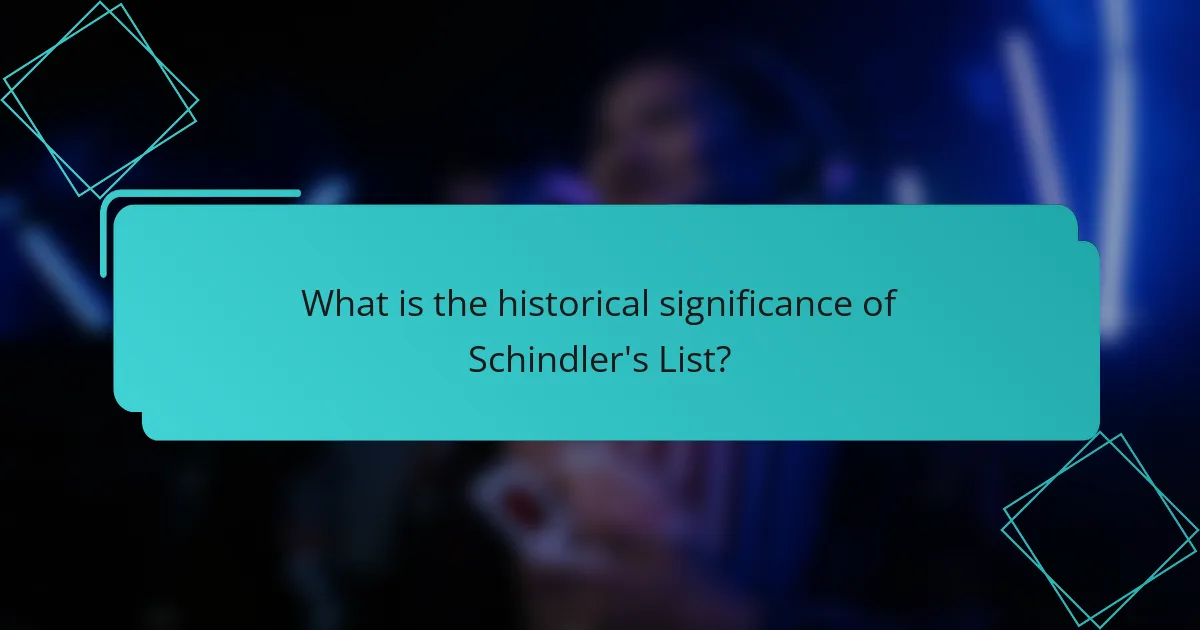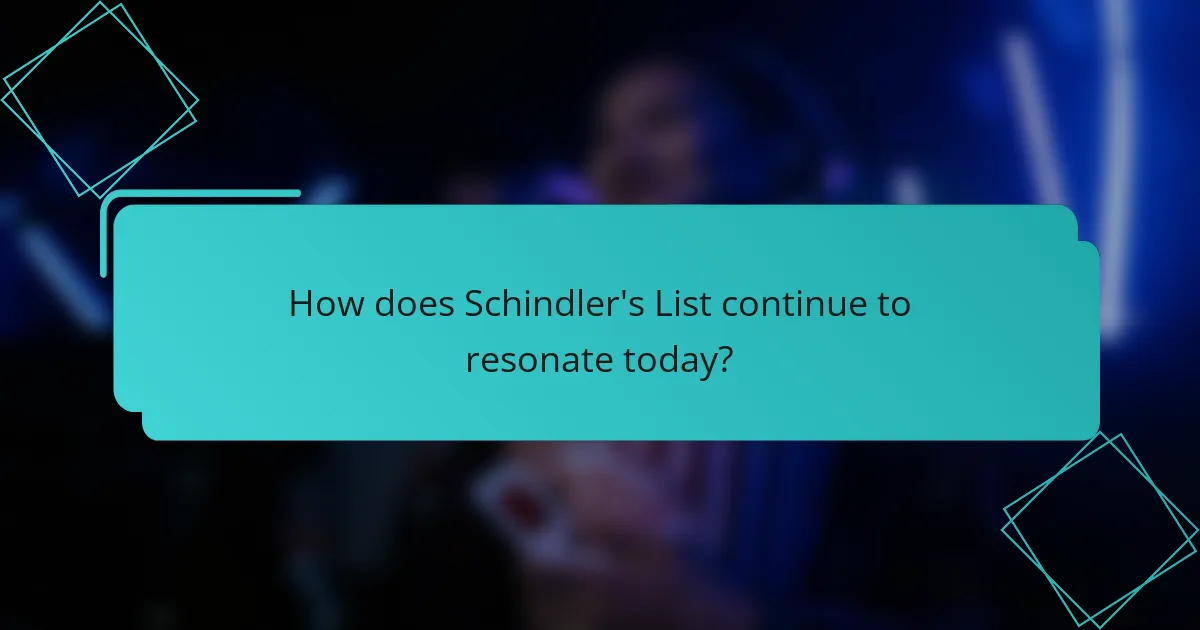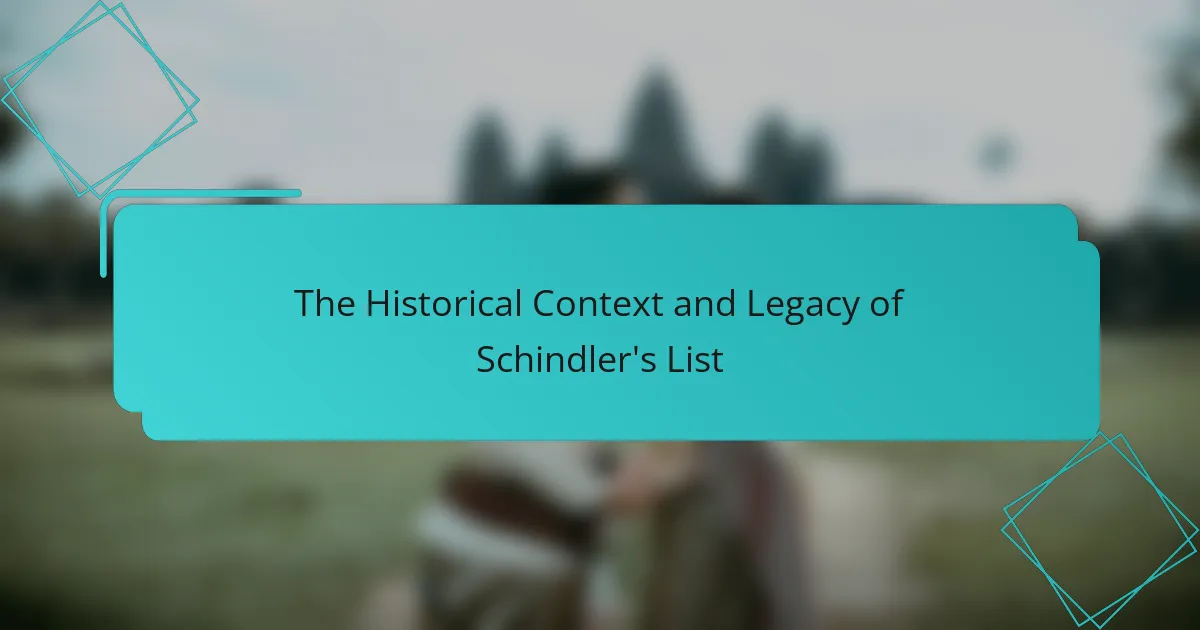Schindler’s List is a significant film directed by Steven Spielberg, released in 1993, that portrays the true story of Oskar Schindler, a German businessman who saved over 1,200 Polish Jews during the Holocaust. The film highlights the atrocities of the Holocaust and explores the moral complexities of human behavior in wartime. It won seven Academy Awards and has become a crucial educational tool, raising awareness about the Holocaust and promoting human rights. Schindler’s List continues to resonate today, serving as a reminder of the importance of tolerance and the dangers of hatred, while fostering empathy and understanding through its historical accuracy and emotional depth.

What is the historical significance of Schindler’s List?
Schindler’s List is historically significant as it highlights the Holocaust’s atrocities and the moral complexities of human behavior during wartime. The film, directed by Steven Spielberg, was released in 1993 and is based on the true story of Oskar Schindler. Schindler, a German businessman, saved over 1,200 Polish Jews from extermination by employing them in his factories. This act of bravery and compassion amidst widespread indifference and cruelty is a powerful narrative of resistance against oppression.
The film brought global attention to the Holocaust, educating audiences about the horrors faced by Jews during World War II. It won seven Academy Awards, including Best Picture and Best Director, which further solidified its impact on popular culture. The historical accuracy of the film is supported by extensive research and testimonies from survivors, making it a crucial educational tool. Schindler’s List serves as a reminder of the importance of remembering history to prevent future atrocities.
How does Schindler’s List reflect the events of the Holocaust?
Schindler’s List reflects the events of the Holocaust by depicting the systematic extermination of Jews during World War II. The film illustrates the brutality of Nazi policies through graphic portrayals of violence and oppression. It showcases the plight of Jewish individuals and families facing persecution. Oskar Schindler, the film’s protagonist, represents a rare act of humanity amidst widespread atrocity. His efforts to save over a thousand Jews highlight the moral complexities of the time. The film uses historical events, such as the liquidation of the Kraków ghetto, to ground its narrative in reality. It emphasizes the importance of individual choices during collective tragedy. Schindler’s List serves as a poignant reminder of the Holocaust’s horrors and the resilience of the human spirit.
What are the key historical events depicted in Schindler’s List?
Schindler’s List depicts key historical events during the Holocaust. The film illustrates the persecution of Jews in Nazi-occupied Poland. It shows the establishment of the Kraków ghetto in 1941. The film highlights the brutal conditions faced by Jewish families. It portrays the liquidation of the ghetto in 1943. The events include deportations to concentration camps. The narrative focuses on Oskar Schindler’s efforts to save Jewish lives. He employs over a thousand Jews in his factory, protecting them from deportation. These events reflect the broader atrocities of the Holocaust.
How does the film portray the experiences of Jewish individuals during this period?
The film portrays the experiences of Jewish individuals during this period as harrowing and deeply traumatic. It depicts the systematic persecution faced by Jews under Nazi rule. Scenes illustrate the brutality of the Holocaust, including mass deportations and executions. The film also highlights the loss of family and community among Jewish people. Through personal stories, it conveys the despair and hopelessness experienced by many. Key characters represent the struggle for survival amidst overwhelming odds. The film’s historical accuracy reinforces the reality of these experiences. It serves as a poignant reminder of the atrocities committed against Jewish individuals during this dark chapter in history.
Why was Schindler’s List created and who was its intended audience?
Schindler’s List was created to depict the Holocaust and raise awareness of its atrocities. The film aimed to honor the memory of the victims and highlight the moral complexities faced during that time. Its intended audience included both general viewers and those specifically interested in historical events related to World War II. The film serves as an educational tool, fostering understanding of the Holocaust’s impact on humanity. It was directed by Steven Spielberg and released in 1993. The film received critical acclaim and won several awards, reinforcing its significance in historical discourse.
What motivated Steven Spielberg to direct Schindler’s List?
Steven Spielberg was motivated to direct Schindler’s List due to his deep sense of responsibility to tell Holocaust stories. He aimed to educate audiences about the atrocities committed during World War II. Spielberg’s Jewish heritage influenced his desire to honor the victims and survivors. He sought to create a powerful narrative that would preserve the memory of those who suffered. The film was also a personal journey for Spielberg, as he grappled with his own family’s history. He felt a moral obligation to confront the horrors of the Holocaust through cinema. Spielberg believed that storytelling could foster understanding and empathy. His commitment to historical accuracy and emotional truth drove the film’s production.
How did the film’s release impact public perception of the Holocaust?
The film’s release significantly altered public perception of the Holocaust. It brought the atrocities of the Holocaust into mainstream awareness. The portrayal of personal stories humanized the victims. This emotional engagement fostered empathy among audiences. Many viewers reported increased interest in Holocaust education after watching the film. Scholarly studies noted a rise in Holocaust-related discussions in media and education. The film also contributed to a greater acknowledgment of survivor testimonies. Overall, it played a crucial role in shaping contemporary understanding of the Holocaust.

What are the lasting legacies of Schindler’s List?
The lasting legacies of Schindler’s List include its impact on Holocaust education and its role in promoting human rights. The film has educated millions about the Holocaust, highlighting the atrocities faced by Jewish people during World War II. It serves as a powerful reminder of the consequences of hatred and intolerance. Schindler’s List has also inspired humanitarian efforts and advocacy for human rights worldwide. The character of Oskar Schindler exemplifies moral courage, encouraging individuals to take action against injustice. The film’s historical accuracy and emotional depth have made it a critical resource in academic settings. Its influence extends to various forms of media, shaping public discourse on genocide and moral responsibility.
How has Schindler’s List influenced Holocaust education?
Schindler’s List has profoundly influenced Holocaust education by providing a powerful narrative of human compassion amidst atrocity. The film offers a personal perspective on the Holocaust, making the historical events more relatable to audiences. It highlights the moral choices made by individuals in dire circumstances. This emotional connection fosters deeper engagement and understanding of the Holocaust’s impact. Educational institutions have incorporated the film into curricula to enhance teaching methods. Studies show that visual storytelling can improve retention of historical facts. Schindler’s List serves as a catalyst for discussions on ethics, humanity, and the consequences of indifference. Its legacy continues to shape how future generations learn about this critical period in history.
What role does the film play in teaching about moral choices during wartime?
The film plays a significant role in teaching about moral choices during wartime by illustrating the complexities of human behavior in extreme situations. It portrays the moral dilemmas faced by individuals during the Holocaust. Schindler’s actions demonstrate the impact of personal choices on the lives of others. The film emphasizes the importance of empathy and courage in the face of injustice. It presents a narrative that encourages viewers to reflect on their own values and actions. Historical context enhances the understanding of the consequences of inaction. The depiction of both heroism and complicity serves as a powerful reminder of moral responsibility. This multifaceted representation fosters critical discussions about ethics in warfare.
How has the film been used in classrooms worldwide?
The film “Schindler’s List” has been used in classrooms worldwide as an educational tool to teach about the Holocaust. It serves to illustrate the moral complexities of human behavior during one of history’s darkest periods. Educators utilize the film to foster discussions on ethics, empathy, and historical awareness. Many history and social studies curricula include it as a primary resource for understanding the impact of World War II. Research indicates that films like “Schindler’s List” enhance student engagement and retention of historical facts. The film’s powerful imagery and storytelling facilitate deeper emotional connections to the subject matter. Schools often accompany the film with guided discussions and supplementary materials to maximize its educational value.
In what ways has Schindler’s List impacted popular culture?
Schindler’s List has significantly impacted popular culture by raising awareness of the Holocaust. The film brought the horrors of this historical event to mainstream audiences. Its emotional storytelling has influenced various artistic expressions, including literature, theater, and visual arts. The film’s iconic imagery has become a reference point in discussions about genocide and human rights. Additionally, it has inspired educational programs and documentaries aimed at teaching about the Holocaust. Schindler’s List has also been referenced in numerous other films and television shows, showcasing its lasting influence. Its success at the Academy Awards, including seven Oscars, solidified its place in cinematic history. Overall, the film has contributed to a broader cultural understanding of the consequences of hatred and intolerance.
What references to Schindler’s List can be found in other media?
References to Schindler’s List can be found in various forms of media, including films, television shows, and literature. The film has influenced numerous creators and storytellers. For instance, the TV series The Simpsons has parodied scenes from Schindler’s List in episodes like “The Burns and the Bees.” Additionally, the film’s iconic imagery and themes have been referenced in movies such as Life Is Beautiful, which explores similar Holocaust narratives. In literature, the book The Boy in the Striped Pajamas draws on the moral complexities depicted in Schindler’s List. Music also reflects its impact; for example, the song “What Have We Done” by David Bowie alludes to the themes of morality and humanity present in the film. These references highlight the enduring influence of Schindler’s List across various media platforms.
How has the film shaped the narrative around Oskar Schindler?
The film “Schindler’s List” has significantly shaped the narrative around Oskar Schindler by portraying him as a complex hero. The film depicts Schindler’s transformation from a profit-driven businessman to a savior of Jews during the Holocaust. This narrative emphasizes his moral awakening and the risks he took to save lives. The portrayal includes his use of personal resources to protect over a thousand Jews, showcasing his bravery and compassion.
Historical context is provided through powerful imagery and storytelling, which enhances public understanding of the Holocaust. The film’s impact has led to Schindler being recognized not just as a businessman but as a humanitarian. It has influenced how future generations perceive the moral choices made during this dark period in history. The film’s acclaim and educational value have solidified Schindler’s legacy in historical discussions.

How does Schindler’s List continue to resonate today?
Schindler’s List continues to resonate today by serving as a powerful reminder of the Holocaust’s atrocities. The film educates new generations about the importance of tolerance and the dangers of hatred. It highlights the moral complexities faced during times of crisis. The character of Oskar Schindler exemplifies the impact one individual can have in saving lives. Many educational institutions use the film to teach about human rights and ethics. Its emotional storytelling fosters empathy and understanding. The film’s historical accuracy is supported by survivor testimonies and scholarly research. Schindler’s List remains a crucial part of discussions on genocide and humanitarianism.
What lessons can modern audiences learn from Schindler’s List?
Modern audiences can learn the importance of individual action in the face of injustice from Schindler’s List. The film illustrates how one person’s efforts can save lives during horrific circumstances. Oskar Schindler, a German businessman, saved over 1,200 Jews during the Holocaust. His actions highlight the moral responsibility individuals have to stand against oppression. The film also emphasizes the consequences of indifference to suffering. It shows how societal complicity can lead to devastating outcomes. Additionally, it serves as a reminder of the value of empathy and compassion in times of crisis. These lessons remain relevant in addressing contemporary issues of human rights and discrimination.
How can the themes of Schindler’s List be applied to contemporary issues?
The themes of Schindler’s List can be applied to contemporary issues such as human rights violations and moral responsibility. The film highlights the impact of individual actions in the face of systemic injustice. In today’s world, similar patterns of discrimination and persecution continue to occur. For instance, refugee crises and ethnic conflicts reflect the ongoing struggle against oppression. Schindler’s choice to save lives serves as a powerful reminder of the importance of standing up for others. Historical events, like the Holocaust, underline the consequences of inaction. By examining these themes, society can encourage advocacy and empathy in addressing current injustices. The lessons from Schindler’s List remain relevant in fostering a culture of awareness and responsibility.
What discussions does Schindler’s List provoke about human rights today?
Schindler’s List provokes discussions about the importance of human rights and the consequences of their violation. The film highlights the atrocities of the Holocaust, emphasizing the need for vigilance against discrimination and oppression. It serves as a reminder of the fragility of human rights in the face of hatred. The portrayal of Oskar Schindler’s moral choices raises questions about individual responsibility in protecting the rights of others. Additionally, the film encourages reflection on contemporary issues such as genocide, refugee crises, and systemic racism. By illustrating the impact of inaction, Schindler’s List urges society to advocate for human rights today. The historical context of the Holocaust reinforces the necessity of education and remembrance to prevent future violations.
What are some best practices for engaging with Schindler’s List in educational settings?
Engaging with Schindler’s List in educational settings requires thoughtful approaches. First, educators should provide historical context about the Holocaust and Oskar Schindler’s actions. This foundation helps students understand the film’s significance. Next, facilitate discussions that encourage critical thinking about moral choices and human rights. Use guided questions to explore themes such as courage and complicity. Incorporate multimedia resources to enhance engagement, including survivor testimonies and historical documents. Create a safe environment for students to express their thoughts and feelings about the film. Finally, encourage reflective assignments that connect the film’s lessons to contemporary issues. These practices can deepen students’ understanding and foster empathy.
How can educators create meaningful discussions around the film?
Educators can create meaningful discussions around the film “Schindler’s List” by facilitating guided conversations that focus on its historical context. They should begin by providing background information on the Holocaust and its impact. This context helps students understand the significance of the events depicted in the film.
Educators can use discussion questions that encourage critical thinking. Questions might include, “What moral dilemmas did Schindler face?” or “How does the film portray the complexities of human behavior during the Holocaust?” These questions prompt students to engage deeply with the material.
Incorporating primary sources, such as survivor testimonies or historical documents, can enhance discussions. This approach allows students to connect the film to real-life experiences and historical facts.
Group activities, such as role-playing or debates, can also foster engagement. These methods encourage students to express their thoughts and listen to different perspectives.
Finally, educators should create a safe environment for open dialogue. This setting encourages students to explore sensitive topics without fear of judgment.
What resources are available to support teaching about Schindler’s List?
Teaching about Schindler’s List can be supported by various resources. Educational films and documentaries provide visual context. Scholarly articles analyze its historical accuracy and impact. Books about the Holocaust and Oskar Schindler offer in-depth perspectives. Lesson plans and teaching guides are available from educational organizations. Online platforms like the United States Holocaust Memorial Museum provide teaching resources. Discussion forums and workshops help educators share strategies. These resources enhance understanding of the film’s historical context and legacy.
The main entity of the article is “Schindler’s List,” a film directed by Steven Spielberg that depicts the Holocaust and the moral complexities of human behavior during this period. The article explores the historical significance of the film, detailing its portrayal of key events, individual experiences, and the impact it has had on public perception and Holocaust education. It also examines the lasting legacies of Schindler’s List, including its influence on popular culture, discussions about human rights, and best practices for engaging with the film in educational settings. The narrative emphasizes the importance of remembering history to prevent future atrocities and the role of individual actions in combating injustice.
